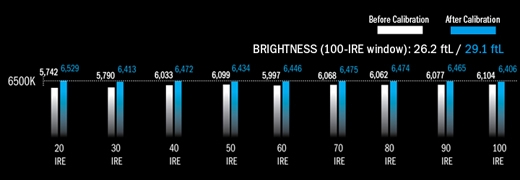Test Report: Pioneer Elite Kuro PRO-111FD 50-inch plasma HDTV Page 3
TEST BENCH

Color Temperature: (Movie mode/Low color temperature before; Standard mode/Low color temperature after calibration):
20 IRE: 5,742 / 6,529 30 IRE: 5,790 / 6,413 40 IRE: 6,033 / 6,472 50 IRE: 6,099 / 6,434 60 IRE: 5,997 / 6,446 70 IRE: 6,068 / 6,475 80 IRE: 6,062 / 6,474 90 IRE: 6,077 / 6,465 100 IRE: 6,104 / 6,406 BRIGHTNESS (100-IRE window): 26.2 ftL / 29.1 ftL
Primary Color Point Accuracy vs. SMPTE HD Standard
| Color | Target X | Measured X | Target Y | Measured Y |
Red | 0.64 | 0.69 | 0.33 | 0.32 |
Green | 0.30 | 0.29 | 0.60 | 0.61 |
Blue | 0.15 | 0.14 | 0.06 | 0.04 |
The Pioneer PRO-111FD's Standard picture preset delivered the most accurate color when its Low color temperature preset was also selected. In that mode, grayscale tracking was ±710 degrees K of the 6,500-K standard from 30 to 100 IRE. Adjustments made to the set's Manual color temperature controls improved grayscale tracking to ±94 degrees K from 10 to 100 IRE - an impressively linear result. Color decoder tests in Standard mode revealed a -10% red and -5% blue error on both the HDMI and component-video inputs. As compared with the SMPTE HD specification, the set's red, green, and blue color points were notably accurate. At around 29 ftL, the set's peak brightness measured somewhat low as compared with other flat-panel sets when in standard mode - a direct effect of the set's Energy Star-certified design. But I never felt that its image looked dim during normal operation; picture brightness in Standard mode proved satisfactory even during daytime viewing in bright ambient light.
Overscan - the amount of picture area hidden behind the edges of the TV screen - measured 0% for 1080i/p-format high-definition signals with Dot by Dot Screen Size screen size selected, and 3% in Full (16:9) mode. The set displayed 1080i test patterns with full resolution on the HDMI inputs, although a degree of noise was visible in the highest frequency bursts with a component-video connection. A 720p multiburst test pattern looked slightly soft via both HDMI and component video. Slight edge enhancement was visible on test patterns with an HDMI connection with the set's sharpness control set to minimum, although any related effects didn't show up on regular programs. Screen uniformity was characteristically excellent for a plasma model, with picture contrast remaining solid at all viewing angles over a near 180-degree near-180º arc.
The Pioneer displayed exemplary video processing. It passed all of the tests contained on both the Silicon Optix HQV high-def and DVD test discs, and those results were mirrored in subjective, real-world evaluation of film and video-based programs. Its upconversion of regular DVDs was also clean and solid. All of the set's various noise reduction settings worked exceptionally well, helping to smooth out grainy images without eliminating a shred of picture detail.
Black is back and darker than ever on the Pioneer Elite Kuro PRO-111FD 50-inch plasma -- the worthy follow-up to last year's S&V Product of the Year.








































